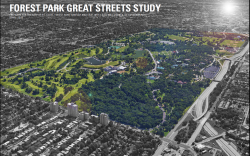In 2017, East-West Gateway initiated the fifth round of Great Streets demonstration projects with the Forest Park project. This project was funded through federal transportation planning grants and local funds provided by the project sponsor.
As the neighborhoods and institutions that surround Forest Park thrive and the institutions within it expand, access to and within the Park is strained. Visitors  to Forest Park arrive mostly by automobile for a range of activities, from leisurely strolls to formal theater productions. Bicyclists enjoy improved regional access due to the expanding regional greenway and bicycle route network. Pedestrians and runners from the adjacent neighborhoods and campuses use the Park daily. Transit access to the Park is provided directly by multiple bus lines and the soon-to-open Loop Trolley, and through three nearby light rail stations. Despite operation of a bus trolley, circulation throughout the Park and adjacent places relies significantly on the use of personal automobiles, which compounds congestion and parking problems and creates numerous conflicts with pedestrians and bicyclists, particularly on peak days and during events. This study will begin to implement the 2016 Connectivity and Mobility Study with specific projects for implementation.
to Forest Park arrive mostly by automobile for a range of activities, from leisurely strolls to formal theater productions. Bicyclists enjoy improved regional access due to the expanding regional greenway and bicycle route network. Pedestrians and runners from the adjacent neighborhoods and campuses use the Park daily. Transit access to the Park is provided directly by multiple bus lines and the soon-to-open Loop Trolley, and through three nearby light rail stations. Despite operation of a bus trolley, circulation throughout the Park and adjacent places relies significantly on the use of personal automobiles, which compounds congestion and parking problems and creates numerous conflicts with pedestrians and bicyclists, particularly on peak days and during events. This study will begin to implement the 2016 Connectivity and Mobility Study with specific projects for implementation.
By applying the principles of Great Streets to the access routes to, around and within Forest Park, the Forest Park Great Streets Study will develop a multi-modal access and circulation strategy which increases the safety, convenience, accessibility to and within Forest Park resulting in an improved visitor experience.

